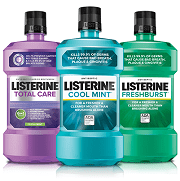Listerine for Toenail Fungus – Does it work?

If you have stumbled across this post then you are probably searching for an inexpensive way to clear up your toenail fungus fast, efficiently, and from the comfort of your home. In this search, you may have heard of people using Listerine to treat nail fungus.
Listerine does a great job of killing germs in peoples’ mouths fresh but what about on your toes?
In this article, Toe Fungus Journey is going to give you a complete guide about Listerine for nail fungus infections and answer the question – should you use it?
Ingredients that kill fungal spores
Listerine is known for its ability to kill germs in the mouth but what about on the feet?
There are many active ingredients that are known to be useful against nail fungi such as:
- Menthol,
- Methyl salicylate
- Eucalyptol
- Thymol.
These four active ingredients found in Listerine can be used to kill fungal spores that could be causing the discoloration of your toes.
Research and studies
Listerine may contain individual active ingredients that can help with very mild toenail fungal infections but is there any research supporting these claims?
The Internet is full of anecdotal claims that Listerine has worked for people but no one knows the severity or condition of their nails when they started treatment.
Currently, there are no scientific or peer-reviewed studies about the effects of Listerine on toenail fungus. All that is known is that Listerine does contain a few active ingredients that have shown positive effects on the fungus.

But if you want quicker results that are actually formulated to work then I would consider browsing alternative treatments that can be found on this website.
Should you use Listerine for fungal infections?
Considering there is no conclusive evidence or scientific studies that Listerine actually works for nail fungus should say a lot about a treatment.
At Toe Fungus Journey, we advise against the use of Listerine for toenail fungus especially if your infection is more severe. Instead, you should use products designed for the treatment of onychomycosis AKA nail fungus.
Pros and Cons
Pros
- Can be purchased over-the-counter
- Inexpensive to buy
- Generally safe
- Convenient to use
- Contains ingredients that can help nail fungus
Cons
- No evidence of it actually working
- Poorly researched (No scientific evidence to support claims)
- Can take a long time to see results
- Exposes unaffected nails
How does it work? How to use it?
While Toe Fungus Journey does not advocate using Listerine as a solution for toenail fungus due to the lack of evidence of it actually working, we decided to provide instructions if you decide to pursue this as a remedy.
If you came to this article to learn how to use a Listerine foot soak for fungus then follow the instructions below
- Find a tub that has the depth and length to fit both of your feet. A foot spa can work as well.
- Fill the tub with 50% Listerine and 50% warm water
- You may add vinegar instead of water to increase the level of acidity of the soak
- Soak your feet in the solution for 45-60 minutes
- Use this soak every day until the fungus subsides. It can also be used as a preventative measure.
- Dry feet properly after each soak to prevent moisture!
If you are short on time then you can apply Listerine directly to your nails using a Q-Tip.
Other things you can add to the soak to make it more effective:
- Apple cider vinegar
- Hydrogen peroxide
- White vinegar
- Tea tree oil
- Eucalyptus oil
Summary
While Listerine is great for fighting germs in the mouth there isn’t enough conclusive evidence to recommend this product as a way to treat toenail fungus.
There a number of proven products that have been backed with scientific studies that are just as easy and convienent to use.

